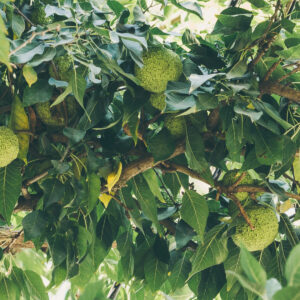Showing the single result
Wholesale Osage Orange Trees in Michigan
Based in Free Soil, Michigan, Cold Stream Farm grows, sells, and distributes wholesale Osage orange trees. We have no minimum order on Osage orange plant shipments with retail and wholesale pricing for customers in the United States and Canada. Our Osage orange trees can be purchased at various life stages throughout the year, with 1 to 2-foot transplants available primarily in the spring.
What is an Osage orange tree?
Cold Stream Farm supplies Osage orange trees (Maclura pomifera), which are large deciduous shrubs that are native to Texas, Oklahoma, and Arkansas.
The southern American species has many nicknames including the Osage orange tree, hedge apple, hedge apple tree, mock orange, and horse apple. Translated from the French “bois d’arc,” the plant has also earned the nicknames of Bow-wood, bodark, monkey-ball, and monkey-brains.
History of the Tree and its Name
The Osage tree is named for the Osage Nation Native American tribe. Although the Osage Nation was located primarily above the tree’s natural range, Maclura pomifera got its name from Jean-Pierre Chouteau, who spent much of his time with the people.
Upon its discovery from American settlers, Osage orange trees quickly became popular in gardens and properties throughout the new west in cities like St. Louis. It is now naturalized all across the country from New England to the Pacific Northwest.
How to Identify an Osage Orange Tree
The Osage orange tree is most recognized by its distinctive fruit, which is not actually an orange or even orange in color. An Osage orange turns yellowish-green in the fall and matures to be about 5 inches in diameter covered by a rough, bumpy surface.
Size, Shape, and Color
A mature Osage orange tree grown in ideal conditions will reach mature heights up to about 50 feet. The plants have small trunks with a large canopy filled with long, oval-shaped leaves. Osage leaves are bright green in the spring and summer before fading to orange in the fall.
Osage Orange flowers are tough to spot, growing only into small, pale-green blooms. The bark, roots, and wood are all very strong and thick with thorns found on the plant’s branches.
Ideal Osage Orange Growing Habitats
Maclura pomifera grows best in USDA Hardiness zones 4-10. In order for the plants to produce fruit, both male and female plants must be grown in close proximity to each other. The plant’s roots have significant potential to spread through unmaintained areas of a property if left unattended.
Popular Uses for Osage Orange Trees
For centuries, the Osage orange Tree has been a popular hedge plant and windbreak in North America. The plant’s hardiness has allowed it for use in many growths and soil repair projects, while its thorns help deter both people and predators for livestock.
The fruit of an Osage orange tree is edible, and primarily consumed by cows, horses, and other livestock. It is said to have a cucumber-like taste and is also popular among squirrels, deer, and other wildlife life.
Using Osage Orange Wood
Aside from being used in hedges and windbreaks, the strong and flexible wood of an Osage tree has made it useful for a few different applications. Primarily, the tree was nicknamed “bow-wood” because members of the Osage Nation would travel hundreds of miles to use the material in bow making. Beyond this, the wood has been used for instruments and bird calls.
Osage Orange Trees as an Insect Repellant
Fruit from an Osage orange tree is celebrated for its ability to repel insects such as flies, mosquitos, and spiders. Simply pick ripe fruit and scatter its bits around the foundation of your home to prevent unwanted crawlers from entering your living space.
Although the science behind Maclura pomifera as an insect repellent has been occasionally negated, the plant itself is very robust and durable against infestations. Growers rarely have insect-related ailments, diseases, or issues with Osage orange trees.
How to Plant and Maintain Osage Orange Trees
Osage orange plants reproduce easily from both the seeds from fruit and cuttings. They are best started indoors, but should not be transplanted once rooted in the ground. When placing the tree in its final location, be sure to allow for several feet of trunk diameter growth.
In its infancy, it is best to keep the soil around an Osage orange tree moist and well-watered. Once over a year old, Osage orange plants can withstand just about any growing conditions, thriving in otherwise poor soil where many plants could not survive.
Purchase wholesale Osage orange trees with us.
If you are ready to get started with your order, please check our current availability of wholesale Osage orange trees for purchase. Cold Stream Farm has a limited supply of Osage orange plants in Michigan, with shipping directly from our farm to your property. Please give us a call if you have any questions about delivery, the genders of certain plants, or future availability.


